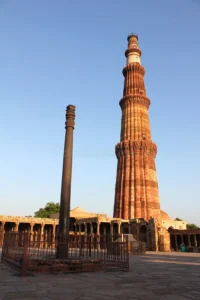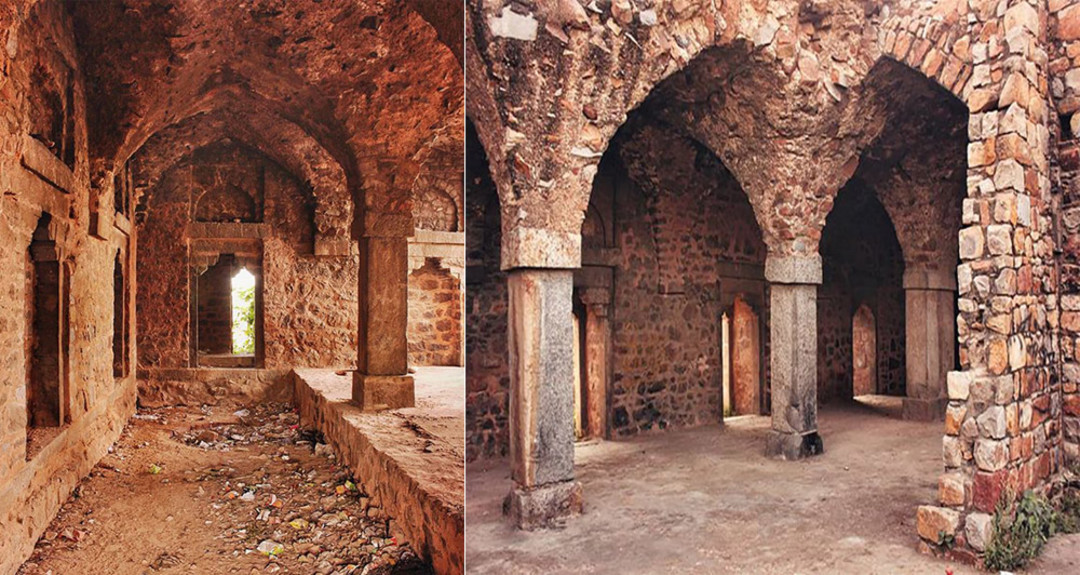Did you know that the city of Delhi went under a series of destruction and reconstruction before finally becoming the Lyuten’s New Delhi? That the city has lived 7 lives before its present one?
In the last blog of Delhi, we discussed the historical importance of the monuments built by the Sultans of the Delhi Sultanate. However, as the quote goes,
Dil kī bastī bhi Shehar dillī hai
jo bhī guzrā us ne luuTā hai
(Delhi alone is the city of love,
Whoever has passed has looted it)
– BASHIR BADR

Delhi’s history does not limit itself to the invasion of Muhammad Ghori only, or to the ruling of the bright Rajput kings, the Tomars and Chauhans. The mention of Delhi is also in the Hindu epic of Mahabharata, under the name Indraprastha or in other Buddhist scripts (Indapatta). However, the later Islamic invasions and their formed cities are taken in account.
In this blog we will be exploring the 7 ancient cities that made Delhi what it is now.
INDRAPRASTHA
Indraprastha is believed to be the kingdom which was given to the Pandavas as a compensation for the throne of Hastinapur. The era being around 9th and 8th Century. The Pandavas were given a forest named Khandavaprastha near the Yamuna River which they cleared down to build the kingdom of Indraprastha. The newly formed Kingdom was a product of marvellous engineering making the Kauravas jealous.
Indraprastha is also mentioned as Indapatta (its Pali name) in many of the Buddhist texts as the capital of Kuru Mahajanapada. Along the way were the descendants of the Pandavas and other Mauryan emperors until came the Tomars and the Rajputs.
Location: the then Indraprastha is now the region around the Purana Qila.
1. LAL KOT AND MEHRAULI
The very first city of Delhi is believed to be founded by the Rajput Tomars, with them building a regular defence fort named Lal Kot, which only inspired the name of the region. Prithvi Raj Chauhan (famously known as Rai Pithora) extended this fort to cover a huge distance of his Kingdom around in 1160 AD. The Surajkund and Anangpur dam (Anangpur village near Faridabad) are some of the monuments of their reign however, while their temples and other shrines were destroyed during the Islamic invasion.
Muhammad Ghori’s general, Qutubuddin Aibak became the first Sultan of Delhi and built the capital on the site of the Lal Kot which later came up as Mehrauli.
The Mehrauli region now is like a reserve for many historical monuments like the Mehrauli archaeological park, Qutb complex, Zafar Mahal and many Tombs etc.

Location: The Mehrauli region of the New Delhi city.
2. SIRI
Alauddin Khiji, the ruler of the Khilji dynasty founded the city of Siri. He also well known for his famous works of architecture like the Alai Darwaza and Alai Minar in the Qutb Complex and the famous Hauz Khas. It is believed that the city of Siri was named after the word ‘Sir’ which means head as it is believed that Alauddin Khilji beheaded almost 8,000 Mongols of the nearby Mongol settlement. Alauddin built the Qasr-i-Hazar Sutoon, a thousand pillar, wooden palace which is now in ruins.

Location: The city was created between 1297 to 1307 AD and is situated near the present-day Siri Fort area.
3. TUGHLAQABAD
The third city of the medieval Delhi, Tughlaqabad (1321-25 AD) was founded by Ghiyasuddin Tughlaq (also the founder of Tughlaq Dynasty). A fortified city with massive walls and glorious gates, Tughlaqabad’s fate contrasted with its massiveness. It is believed that the king was cursed by the Saint Nizamuddin Auliya, which led to the short life of the city. Auliya prophessed that the city would be inhabited either by the Gujjars or would be abandoned, considering the present state, it is now actually inhabited by the Gujjars. The beauty and power of the city declined gradually and is still decaying in one corner of the city, while in contrast the Nizamuddin Dargah, the mausoleum of saint Nizamuddin is among the most visited shrines.

Location: near the Okhla Industrial area.
4. JAHAPANABAD
A city that was abandoned within a year (1326-27), this city famously known for its ‘mad king,’ Muhammad bin Tughlaq. The fort of Jahapanah (‘Jahan’ refers to the world and ‘Panah’ means refugee) was built to counter the threats of the Mongol invasion, however the king later decided to shift the capital from Jahapanabad to Daulatabad. This decision of changing the capital is regarded as one of the most scandalous decisions in the history. The migration killed a lot of people and the land of Daulatabad was very infertile and barren leading to more disasters.
Location: You can find the Fort of Jahapanabad (known as Bijay Mandal) among the residential colonies of the South Delhi.
5. FIROZABAD
Firozabad, a city built under the guidance of the new Sultan of the Tughlaq dynasty, Feroz shah Tughlaq. Location: near the Firoz Shah Kotla stadium. The city although short lived became one of blessed and flourished city of all times with merchants coming all over from Asia. The city had a great water management system with canals, wells, and water channels. The Firoz Shah Kotla brought in fame for its beauty and rich heritage, however it led to a series of plunders and invasions. In around 1398 the capital of Delhi witnessed a nightmare in form of Timur, the Mongol chief who plundered Delhi. This brought an abrupt end of the Tughlaq dynasty.
Location: the area near the Firoz Shah Kotla stadium.
6. DINPANAH, THE LOST CITY
The fourth medival city of Delhi, Dinpanah was designed by the Mughal Emperor Humayun himself. Also known as Adinaabad, the city was a mix of Persian, Turkish and Indian architectural styles. Dinpanah however was abandoned after Humayun’s defeat by Sher Shah Suri who extended Humayun’s city and even built the Purana Qila. Even though after Sher Shah’s death Humayun returned, but he only had the opportunity to rule for seven months before meeting his death. Humayun’s Tomb in the area is one of most beautiful architecture of the city.
Location: the area near Purana Qila.
7. SHAHJAHANABAD, OLD DELHI
The aura of the Purani Dilli can be found in the twists and turns of the road in Shahjahanabad. Popularly known as ‘Old Delhi’ Shahjahanabad was the last city of the medieval Delhi before the foundations of the New Delhi were led. Designed by the Mughal Emperor Shah Jahan, who is popularly known for his fine aesthetics and marvels of architecture, the city comes alive here.
Meandering through the lanes of the bustling markets, the words of Ghalib – Wikipedia rings in one’s ears:
Yeh Duniya maano jism hai
Aur Dilli uski Jaan.
(The world is like the body,
And Delhi is the heart)
The region of old Delhi consists of the famous Lal Qila, the Jama Masjid, famous markets including the Chandini chowk and Chawri Bazar and wonderful cuisines like Paranthas, Nihari, Rogan Josh, Shahi-tukda, etc.

Location: The current Old Delhi area.
CONCLUSION
Every predecessor city of Delhi represents a significant chapter in Delhi’s rich history, showcasing the city’s evolution and cultural heritage. They have left rememberable mark on Delhi’s landscape, making it the vibrant, diverse city that we know today. To know more about these cities, their rulers and architectural wonders visit: Delhi Sultanate: Its Dynasties And Architectural Wonders – ItihaasKiKhoj

